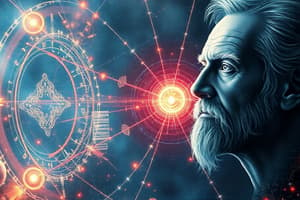Podcast
Questions and Answers
What was the impact of the introduction of quantum theory on physics?
What was the impact of the introduction of quantum theory on physics?
- It unified all branches of physics into a single theory.
- It led to a profound reconstruction rather than destruction. (correct)
- It rendered classical physics obsolete without any further development.
- It completely destroyed the foundations of classical physics.
Who is credited with the introduction of quantum theory in the given content?
Who is credited with the introduction of quantum theory in the given content?
- Richard Feynman
- Albert Einstein
- Max Planck (correct)
- Niels Bohr
In what year did Max Planck discuss the introduction of quantum theory?
In what year did Max Planck discuss the introduction of quantum theory?
- 1887
- 1920
- 1945
- 1931 (correct)
What does the statement imply about the nature of quantum theory?
What does the statement imply about the nature of quantum theory?
Which statement best summarizes the author's view on quantum theory?
Which statement best summarizes the author's view on quantum theory?
What fundamental concept did Planck introduce regarding the frequencies at which atoms can vibrate?
What fundamental concept did Planck introduce regarding the frequencies at which atoms can vibrate?
Which major contribution is Paul Dirac known for in the realm of particle physics?
Which major contribution is Paul Dirac known for in the realm of particle physics?
What was a key distinction that Planck made regarding photons that set it apart from classical physics?
What was a key distinction that Planck made regarding photons that set it apart from classical physics?
Which position did Paul Dirac hold at Cambridge University during his career?
Which position did Paul Dirac hold at Cambridge University during his career?
What did Planck calculate to be the same value throughout the known universe?
What did Planck calculate to be the same value throughout the known universe?
Flashcards
Quantum Theory
Quantum Theory
A fundamental shift in our understanding of the physical world, replacing classical physics with a new set of rules governing energy, matter, and their interactions at the atomic and subatomic scales.
Reconstruction of Physics
Reconstruction of Physics
The introduction of quantum theory didn't demolish physics, but rather redefined its foundations, offering a new way of looking at the universe at the smallest level.
Modern Physics
Modern Physics
In the early 20th century, a new understanding of the physical universe emerged, moving beyond classical physics and embracing a new set of rules.
Atomic and Subatomic Scales
Atomic and Subatomic Scales
Signup and view all the flashcards
Planck and Quantum Theory
Planck and Quantum Theory
Signup and view all the flashcards
Planck's Constant
Planck's Constant
Signup and view all the flashcards
Quantum Mechanics
Quantum Mechanics
Signup and view all the flashcards
Quantum Field Theory
Quantum Field Theory
Signup and view all the flashcards
Antimatter
Antimatter
Signup and view all the flashcards
Dirac Equation
Dirac Equation
Signup and view all the flashcards
Study Notes
Quote by Max Planck
- "The introduction of quantum theory led not to the destruction of physics, but to a somewhat profound reconstruction."
- Quote attributed to Max Planck, 1931
Studying That Suits You
Use AI to generate personalized quizzes and flashcards to suit your learning preferences.
Description
This quiz explores the profound impact of quantum theory on the field of physics. It covers key figures like Max Planck and Paul Dirac, their contributions, and the fundamental shifts in understanding that arose from quantum mechanics. Test your knowledge about the concepts and historical significance of quantum theory.





